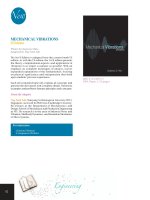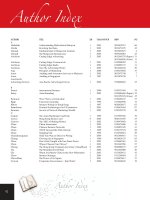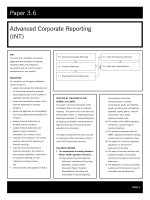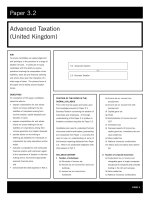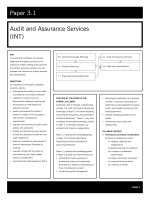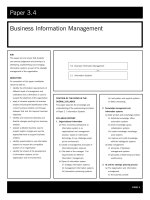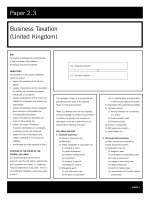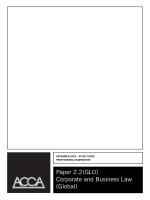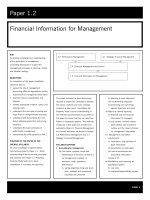acca test book Advanced Corporate Reporting ppsx
Bạn đang xem bản rút gọn của tài liệu. Xem và tải ngay bản đầy đủ của tài liệu tại đây (348.62 KB, 7 trang )
PAGE 3
Paper 3.6
Advanced Corporate Reporting
(INT)
3.6 Advanced Corporate Reporting
3.1 Audit and Assurance Services
2.5 Financial Reporting
1.1 Preparing Financial Statements
2.6 Audit and Internal Review
AIM
To ensure that candidates can exercise
judgement and technique in corporate
reporting matters encountered by
accountants and can react to current
developments or new practice.
OBJECTIVES
On completion of this paper candidates
should be able to:
• explain and evaluate the implications of
an accounting standard or proposed
accounting standard for the content of
published financial information
• explain and evaluate the impact on the
financial statements of business
decisions
• explain the legitimacy and acceptability
of an accounting practice proposed by a
company
• prepare financial statements for
complex business situations
• analyse financial statements and
prepare a report suitable for
presentation to a variety of users
• evaluate current practice in the context
needs of users and the objectives of
financial reporting
• evaluate current developments in
corporate reporting in the context of
their practical application, implications
for corporate reporting, and the
underlying conceptual issues
and
• demonstrate the skills expected in Part 3.
POSITION OF THE PAPER IN THE
OVERALL SYLLABUS
This paper is the final assessment of the
candidates' skills in the area of corporate
reporting. The paper builds on the technical
skills studied in Paper 1.1 Preparing Financial
Statements and Paper 2.5 Financial Reporting
by requiring candidates to demonstrate the
high level technical and evaluatory skills
expected of an accountant.
The paper complements the skills acquired
in studying the other core papers in Part 3
of the ACCA examination structure.
SYLLABUS CONTENT
1 The International Accounting Standard
Board's (IASB) regulatory framework
(a) International Financial Reporting
Standards, International Accounting
Standards, Exposure Drafts,
Discussion Papers, Standard
Interpretations Committee and
International Financial Reporting
Interpretations Committee
pronouncements, including
accounting for equity and liabilities,
assets, provisions and contingencies,
segments, related parties, financial
instruments, taxes, leases,
retirement benefit costs.
(b) The content of the IASB's regulatory
framework in a given range of
practical situations.
(c) The problems associated with the
IASB's regulatory framework including
measurement and recognition issues.
(d) The impact of current and proposed
regulations on the financial
statements of the entity.
(e) The effect of business decisions and
proposed changes in accounting
practice by the entity on the financial
statements.
(f) The legitimacy of current accounting
practice and its relevance to users of
corporate financial statements.
PAGE 4
2 Preparation of the financial statements
of complex business entities
(a) The financial statements of complex
groups including vertical and mixed
groups.
(b) Group cash flow statements.
(c) Accounting for group reorganisations
and restructuring including demergers,
take-overs and group schemes.
(d) Accounting for foreign currency
transactions and entities.
3 Preparation of reports for external and
internal users
(a) Appraisal of financial and related
information, the purchase of a
business entity, the valuation of shares
and the reorganisation of an entity.
(b) Appraisal of the impact of changes in
accounting policies and the regulatory
framework on shareholder value.
(c) Appraisal of the business performance
of the entity including quantitative and
qualitative measures of performance
and the potential for corporate failure.
(d) The assessment of the impact of
price level changes and available
methods of valuation on business
decisions and performance.
(e) The effectiveness of corporate
governance within an entity.
4 Current issues and developments
(a) The accounting impact of
environmental, cultural and social
factors on the entity.
(b) The impact of the content of financial
statements on users including changes
in design and content of interim and
year-end financial statements and
alternate ways of communicating
results to users.
(c) Proposed changes in the structure of
national and international regulation
and the impact on global
harmonisation and standardisation.
(d) The applicability of the IASB's
regulatory framework to small and
medium sized entities.
(e) Current developments in corporate
reporting.
5 Ethical considerations
(a) Ethics and business conduct.
EXCLUDED TOPICS
The following topic is specifically excluded
from the syllabus:
• Disclosure in Financial Statements of
Banks and Similar Financial
Institutions.
KEY AREAS OF THE SYLLABUS
Key topic areas are as follows:
• group accounting, group cash flow
statements and foreign currency
translation
• discussion papers, exposure drafts,
International Accounting Standards and
recent International Financial Reporting
Standards
• problems with current International
Accounting Standards and International
Financial Reporting Standards and the
impact of changes therein on the entity
• preparation of reports in an advisory
capacity including share valuation, and
purchase of a business
• changes in organisational structure,
reconstructions, demergers, etc.
• the potential for business failure and
problems with the business including
financial analysis, corporate failure
prediction and measurement of
corporate performance
• environmental and social accounting
and the impact of culture
• corporate governance and the
dissemination of information to users
• current issues.
The main thrust of the syllabus will be the
preparation of a set of group financial
statements, advising clients on current
standards and changes therein, reporting
business performance including
environmental and social reporting and
corporate governance, and appraising current
issues. It is important to realise that other
areas of the syllabus will be also examined.
APPROACH TO EXAMINING THE
SYLLABUS
The examination is a three hour paper
divided into two sections.
Advanced Corporate Reporting (INT) (Continued)
PAGE 5
Section A will normally comprise one
compulsory question on group financial
statements including group cash flows and
foreign currency translation. This question
will be technically demanding and could
have a discursive element in it.
Section B will comprise four questions out of
which candidates should select three
questions. These questions will involve
advising, discussing and reporting on issues
and topics in corporate financial reporting.
The questions will view the subject matter
from the perspective of the preparer of
financial statements and from the perspective
of the accountant as an advisor. Invariably a
technical understanding of the subject matter
will be required and candidates will have to
apply their knowledge to given cases and
scenarios.
Advice as to current and future reporting
requirements and their impact on reported
corporate performance will be an important
element of these questions. Additionally
current issues and developments in
financial reporting will be examined on a
discursive basis.
Number
of marks
Section A: One compulsory
question 25
Section B: Choice of 3 from 4
questions (25 marks each) 75
100
ADDITIONAL INFORMATION
Candidates need to be aware that questions
involving knowledge of new examinable
regulations will not be set until at least six
months after the last day of the month in
which the regulation was issued.
The Study Guide provides more detailed
guidance on the syllabus. Examinable
documents are listed in the ‘Exam Notes’
section of student accountant.
RELEVANT TEXTS
There are a number of sources from which
you can obtain a series of materials written
for the ACCA examinations. These are
listed below:
Foulks Lynch – ACCA's official publisher
Contact number: +44 (0)20 8831 9990.
Website: www.foulkslynch.com
Accountancy Tuition Centre (ATC)
International
Contact number: +44 (0)141 880 6469.
Website: www.ptc-global.com
BPP
Contact number: +44 (0)20 8740 2211.
Website: www.bpp.com
The Financial Training Company
Contact number: +44 (0)174 785 4302.
Website: www.financial-training.com
Advanced Corporate Reporting (INT) (Continued)
STUDY SESSIONS
1 Overview of the role of the
International Accounting Standards
Board (IASB)
(a) Discuss the nature of the changing
role of the IASB
(b) Describe the applicability of
International Accounting Standards
and International Financial Reporting
Standards for small companies
(c) Discuss the solutions to differential
financial reporting both nationally
and internationally
(d) Discuss first time application of
International Financial Reporting
Standards
2 Corporate governance
(a) Discuss the role and need for the
international regulation of corporate
governance
(b) Describe the nature of reporting the
corporate governance of the entity
(c) Discuss the need for corporate
governance in small companies
Wider reading is also desirable, especially
regular study of relevant articles in ACCA's
student accountant.
The web site of the International
Accounting Standards Board is a useful
source of information. www.iasb.org.uk
PAGE 6
Advanced Corporate Reporting (INT) (Continued)
3 Group financial statements I
(a) Review the basic principles of
acquisition accounting
(b) Explain and illustrate the principles
of measurement relating to the fair
value of the consideration and the
net assets acquired
(c) Discuss the nature of acquisitions
achieved in stages
(d) Prepare consolidated financial
statements where control is
established by an acquisition in stages
(e) Account for complex group structures
4 Group financial statements II
(a) Explain and illustrate the basic
principles relating to the disposal of
group companies
(b) Discuss and illustrate the treatment
of goodwill on disposal
(c) Apply the principles of accounting
for partial and deemed disposals
5 Uniting of interests
(a) Explain the basic principles and
philosophy of a uniting of interests
(b) Account for equity eliminations,
expenses and dividends of the
subsidiary
(c) Prepare consolidated financial
statements utilising the pooling of
interests method
(d) Determine whether the pooling of
interests method could be used in
specific circumstances and the relative
merits of different methods of
accounting for business combinations
6 Group re-organisations and
restructuring
(a) Discuss the creation of a new
holding company
(b) Explain changes in the ownership of
companies within a group
(c) Discuss the nature of demergers and
divisionalisation
(d) Prepare group financial statements
after re-organisation and
reconstruction
(e) Appraise the benefits of the re-
organisation and restructuring
7 Associates and joint ventures
(a) Account for associates and joint
ventures
(b) Apply the equity and proportionate
consolidation methods of accounting
(c) Prepare group financial statements
including accounting for associates
and joint ventures
(d) Evaluate current proposals for
reporting interests in joint ventures
and similar arrangements
8 Foreign currency
(a) Discuss the recording of transactions
and retranslation of monetary/non-
monetary items at the balance sheet
date for individual entities
(b) Account for the treatment of
exchange differences re the above
(c) Discuss the nature of the accounting
for foreign entities and foreign
operations that are integral to the
operations of the entity
(d) Account for a net investment in a
foreign entity
(e) Prepare group financial statements
incorporating a foreign subsidiary/
associate
(f) Discuss problem areas in foreign
currency transactions for individual
and group companies
9 Group cash flow statements
(a) Discuss the usefulness of cash flow
information
(b) Prepare group cash flow statements
classifying cash flows by standard
headings and including acquisition
and disposal of subsidiaries
(c) Deal with associates, joint ventures
and foreign currencies
10 Non current assets I
(a) Discuss the nature of impairment
and the impairment review
(b) Apply the impairment review and
deal with losses on assets
(c) Account for the amortisation of
goodwill and intangible assets
including impairment
11 Non current assets II
(a) Account for revaluation gains and
losses and the depreciation of
revalued assets
(b) Account for the disposal of revalued
assets
(c) Discuss the effect of revaluations on
realised profits
PAGE 7
Advanced Corporate Reporting (INT) (Continued)
(d) Discuss the problem areas in
accounting for non current assets
(e) Account for investment properties
including fair value and cost models,
and definitional issues
12 Financial instruments I
(a) Account for debt instruments, equity
instruments and the allocation of
finance costs
(b) Account for fixed interest rate and
convertible bonds
(c) Discuss the definition and
classification of a financial instrument
13 Financial instruments II
(a) Discuss the measurement issues
relating to financial instruments
(b) Explain the current measurement
proposals for financial instruments
including the use of current values,
hedging and the treatment of gains
and losses
(c) Describe the nature of the disclosure
requirements relating to financial
instruments
(d) Discuss the key areas where
consensus is required on the
accounting treatment of financial
instruments
14 ‘Off balance sheet’ transactions
(a) Explain the nature of the ‘off balance
sheet’ problem and the principle of
substance over form
(b) Discuss common forms of ‘off
balance sheet’ finance and current
regulation in the area
(c) Discuss the perceived problems of
current regulatory requirements
including measurement and
recognition issues
15 Leases
(a) Discuss problem areas in lease
accounting including classification,
termination, tax variation clauses
(b) Account for sale and leaseback
transactions and recognition of
income by lessors
(c) Discuss and account for proposed
changes in lease accounting and its
impact on corporate financial
statements
16 Segmental Reporting
(a) Discuss the problem areas in
segmental reporting including
definition of segments, common
costs, inter segment sales etc
(b) Discuss the different approaches
used to disclose segmental
information
(c) Discuss the importance of segmental
information to users of financial
statements
17 Accounting for retirement benefit costs
(a) Describe the nature of defined
contribution, multi-employers and
defined benefits schemes
(b) Explain the recognition of defined
benefit schemes under current
proposals
(c) Discuss the measurement of defined
benefit schemes under current
proposals
(d) Account for defined benefit schemes
including the amounts shown in the
balance sheet, income statement
and notes to the account
(e) Discuss perceived problems with
current proposals on accounting for
retirement benefit costs
18 Agriculture
(a) Demonstrate knowledge of the scope
of the current standard
(b) Discuss the recognition and
measurement criteria including
treatment of gains and losses, and the
inability to measure fair value reliably
(c) Demonstrate knowledge of the
treatment of government grants, and
the presentation and disclosure of
information relating to agriculture
(d) Account for biological assets,
agricultural produce at the point of
harvest and government grants
19 Taxation
(a) Discuss the different approaches
to accounting for deferred taxation
(b) Discuss the recognition of deferred
taxation in the balance sheet and
performance statements including
revaluations, unremitted earnings of
PAGE 8
Advanced Corporate Reporting (INT) (Continued)
group companies and deferred tax
assets
(c) Explain the nature of the
measurement of deferred taxation
including tax rates and discounting
(d) Calculate deferred tax amounts in
financial statements
20 Reporting financial performance and
earnings per share
(a) Discuss proposed changes to
reporting financial performance
(b) Explain the rationale behind the
proposed changes in reporting
financial performance
(c) Calculate diluted earnings per share
by reference to dilutive potential
ordinary shares, loss per share and
particular types of dilutive
instruments including partly paid
shares, employee incentive schemes
and contingently issuable shares
21 Post balance sheet events, provisions
and contingencies
(a) Discuss the problems of accounting
for post balance sheet events
including reclassification, window
dressing etc
(b) Discuss the issues relating to
recognition and measurement of
provisions including “best
estimates”, discounting, future
events
(c) Explain the use of restructuring
provisions and other practical uses
of provisioning
(d) Discuss the problems with current
standards on provisions and
contingencies including definitional
and discounting problems
22 Related parties and share based
payment
(a) Discuss the related party issue
(b) Identify related parties (including
deemed and presumed) and the
disclosure of related party transactions
(c) Discuss the effectiveness of current
regulations on disclosure of related
party transactions
(d) Describe the current proposals for
the recognition and measurement of
share-based payment
(e) Show the impact of the proposals on
the performance statements of the
entity
23 Preparation of reports I
(a) Calculate and appraise a range of
acceptable values for shares in an
unquoted company
(b) Advise a client on the purchase of a
business entity
(c) Analyse the impact of accounting
policy changes on the value and
performance on an entity
24 Preparation of reports II
(a) Discuss the financial and non-
financial measures of performance
(b) Describe the procedures in designing
an accounting based performance
measurement system
(c) Appraise the different performance
measures including return on
investment, residual income and
economic value added
(d) Compare target levels of
performance with actual
performance
25 Preparation of reports III
(a) Discuss alternative definitions of
capital employed and measurement
bases for assets
(b) Discuss the impact of price level
changes on business performance
(c) Appraise the alternative methods of
accounting for price level changes
(d) Evaluate the potential for corporate
failure
26 The impact of environmental, social
and cultural factors on corporate
reporting
(a) Appraise the impact of
environmental, social and ethical
factors on performance
measurement
(b) Describe current reporting
requirements and guidelines for
environmental reporting
(c) Prepare an environmental report in
accordance with current practice
(d) Discuss the effect of culture on
accounting and the cultural relativity
of accounting
(e) Discuss why entities might include
socially orientated disclosures in
performance statements
PAGE 9
Advanced Corporate Reporting (INT) (Continued)
(f) Discuss the concept of a social
contract and organisational
legitimacy
(g) Evaluate ethical conduct in the
context of corporate reporting
27 International issues
(a) Evaluate the developments and the
impact on companies of global
harmonisation and standardisation
(b) Assess proposed changes to
international regulation
(c) Identify the reasons for major
differences in accounting practices
(d) Restate overseas financial
statements in line with International
Accounting Standards and
International Financial Reporting
Standards
28 Current issues and developments
(a) Identify ways of improving
communication of corporate
performance, current proposals
relating to year end financial reports
and business reporting on the
internet
(b) Identify problem areas in interim
reporting
(c) Discuss current issues in corporate
reporting including disclosure of
accounting policies, discounting,
insurance, extractive industries and
joint ventures
(d) Discuss current proposals to amend
International Accounting Standards /
International Financial Reporting
Standards.
